Glossary of Buddhist Terms
Followed by
Terms Specific to Vajrayana or Tibetan Buddhism

Glossary of Buddhist Terms
Amrita / Amarit: Translated as the elixir of the Gods, from original Hindu mythology of a drink that could bestow Immortality.
Animal Realm: In Buddhist cosmology, one of the six realms of existence, where the mind is consumed by survival.
Arhat: One who has achieved personal liberation from the endless cycle of birth and rebirth.
Asuras (male) / Asuris (female): Also referred to as Titans, they are originally from Hindu mythology where they are lesser gods who strive to overcome the power of the deities. In Buddhism, they are a symbolic manifestation of the ego, representing certain states of mind.
Bodhi: Meaning to be enlightened or awakened. To have knowledge of the ultimate reality.
Bodhisattva: A being who has achieved awakening and has chosen to reincarnate so as to help alleviate the suffering of all beings. Generally thought of as waiting to achieve nirvana until all other beings have reached enlightenment.
BUDDHA: Most commonly used in English to refer to Shakyamuni Buddha, who was born Prince Siddhartha.
CHAKRA: In Vajrayana or Tantric Buddhism, they are considered energy points in the body. However, the word also has its roots in the word for cosmos.
Daka (male) / Dakinis (female): Divine wrathful beings that in Tantric Buddhism are believed to be intermediaries between practitioners and the transcendental Buddhas.
Deva (male) / Devi (female): Originally from Hinduism Deva is a god. In Buddhism, the are still subject to the endless cycle of existence.
Dharma: Often translated as either the Truth, or the teachings of the Buddha. In particular, this refers to the Four Noble Truths and the Eight-Fold Path.
Dhyani (or Meditation) Buddhas: They are emanations of Adibuddha and serve as the meditation Buddhas. These are five images of the Buddha in meditation, and are considered as different aspects of Buddhahood. In Mahayana and Vajrayana Buddhism, they have evolved in to five "families" representing different cosmic elements and being guardians of five different directions (North, South, East, West, and Center).
Dorje: Tibetan pronunciation of the word Vajra
(see below).
Eightfold Path: This is the path preached by the Buddha as the way to escape from anguish and suffering. The eight qualities are right understanding or view (based on understanding the Four Noble Truths), right thought, right speech, right action, right livelihood, right effort, right mindfulness and right concentration.
Enlightenment: This has been translated as understanding the ultimate reality and escaping the endless cycle of existence and rebirth. It is the point where perfect wisdom and perfect compassion reach balance.
Five Poisons: They are five harmful qualities that are normal to most beings, namely Ignorance, hatred, pride, craving and envy.
Four Noble Truths: One of the basic concepts in all schools of Buddhism, they are the truth that suffering arises from impermanence; The truth that ignorance is the attachment to impermanent objects; The truth that suffering can be overcome by developing an understanding of the ultimate reality; The truth that the Eight-Fold Path is the way to achieve this understanding and liberation from suffering.
Gelupka: This is a Tibetan lineage of Buddhism, headed by the Dalai Lama. It is the largest of the four main schools of Tibetan Buddhism.
God Realm: Literally, it is the universe where the gods dwell, but in Buddhist thought it is a symbol for a heavenly state of mind.
Hinayana: Literally meaning lesser of smaller cart, it is a word describing Theravada Buddhism (see below).
Human Realm: Literally being the world where humans dwell, it is a symbol of the mindstate where one has achieved a balance of compassion and awareness. It is thus considered a main gate on the path to enlightenment.
Hungry Ghosts: Another one of the six worlds, where the pretans dwell. They are beings with a huge stomach and a pinhole for a mouth, and thus are unable to consume enough to satisfy their hunger or cravings.
Karma: Karma is usually translated as the law of cause and effect. That we suffer at present because of past harmful or spiteful actions. Karma underlines the importance of all individuals being responsible for their past and present actions. When taking actions, it is best to look at what effect this will have on others, and why is it that we are taking these actions.
Lama: In Tibetan Buddhism, considered a master of certain areas of Buddhism. May be the head of one or more monasteries.
Mahayana: Literally meaning the "Great Vehicle," it is the school of Buddhism that is prominent in Tibet, Nepal, Bhutan, and East Asia. It has incorporated many of the areas original religious beliefs with the original Theravada beliefs. This school emphasizes the path of the Bodhisattva. Vajrayana is a later developed branch of Mahayana.
Mandala: Used as a point of concentration in Tantric Buddhism, is usually A painted circular diagram or sacred circle which represents the unfolding of the cosmos.
Mantra: Sometimes translated as a chant, it is the repeating of phrases or words to help one concentrate and achieve focus.
Mudra: Buddhist and Hindu images all have particular hand gestures, and these hand gestures have specific meanings. For instance, the right hand of Shakyamuni Buddha reaching down is known as Calling the Earth to Witness.
Nagas: In Hinduism, they were known as gods of rain and fertility, in Buddhism, they became seen as protectors. For example, there is a story of when the Buddha was meditating and it began to rain. A Naga came up behind the Buddha and unfolded its seven-headed hood over the Buddha so the rain would not disturb him. Images of nagas are commonly seen decorating temple staircase and roofs (probably because the roofs are wood and susceptible to fire, and Nagas were traditionally thought to bring rain).
NIRVANA: Considered as the goal of Theravada Buddhist practice, it is the liberation from suffering and departure from the endless cyclic existence.
Nyingmapa: Meaning the "Ancient Ones" it is the oldest of the four main schools of Tibetan Buddhism.
Prajnaparamita: In certain Buddhist texts, they deal with the understanding of the "Perfection of Wisdom."
Rimpoche: In Tibetan Buddhism, it means a Precious One. It is the title of a highly adept Buddhist practitioner.
Rupa: The word literally means form, but is commonly used to refer to Buddhist and Hindu statues.
Samadhi: This word generally means a type of insight gained through either meditation or wisdom. In Thai, the word refers to mediation in general.
Samsara: This means the endless cycle of existence in the impermanent world. It is the goal of Buddhism to escape Samsara.
Sangha: The monkshood as founded by the Buddha.
Skandas: These are the five main aspects of the human psyche or personality. Namely, they are form, sensation, perception, mental formations and consciousness.
Stupa: In Buddhist temples, the Stupa is a structure built to house sacred relics.
Sutra: These are basically written teachings, such as the Lotus Sutra or the Karma Sutra.
Tantra: In Buddhism, Tantra generally refers the Vajrayana school. This school relies more heavily on the practice of yoga, mantras, rituals and visualizations of deities.
Thangkas / Thankas: These are Buddhist paintings that can be rolled up and transported from place to place. Nomads in the Tibetan plateaus favored them, since they could be carried easily. They generally feature paintings of Buddhist deities or Buddhist symbols.
Theraveda: Literally meaning "Path of the Elders," This is the original Buddhist school and remains closest to the teachings of Shakyamuni Buddha and the Pali Canon. The focus of Theravada Buddhism is on individual liberation and concentration on the Four Noble Truths and the Eight-Fold Path. This school of Buddhism is found predominantly in Southeast Asia.
Vajra (Dorje in Tibetan): Often translated as a diamond or as a thunderbolt, it is a symbol used in ritual or found in the hands of various Mahayana deities. They represent either the clear insight (such as a lighting bolt cutting through a darkened sky), or pure understanding (such as the clarity of a diamond).
Vajrayana: Also referred to as Tantric Buddhism, it literally means The Diamond Vehicle and is a branch of Mahayana Buddhism widespread in Tibet. See Tantra above.
Vipassana: This is a form of meditation known as insight meditation, and is considered key to enlightenment by Theravada Buddhists.
Yoga: The English word "Yoke" is derived from this word, and its meaning is "Union" or being connected to something. The understanding is that it is the integration of personal experience into wisdom, both from physical and meditative practices.
Zen: This is one school of the Mahayana branch of Buddhism. It developed in China (where it was known as Chan Buddhism), and spread into Japan and Korea. It has incorporated several ideas from Taoism.
Terms Specific to Vajrayana or Tibetan Buddhism
MAHAYANA AND VAJRAYANA TERMS BODHICITTA "Awakened heart/mind." The union of three supreme qualities - love, compassion, and wisdom - which naturally express themselves as the wish to attain enlightenment for the sake of all sentient beings. Also called "Buddha mind," bodhicitta constitutes the essential experience of the Buddha nature as well as the very means of realizing it. It is the true nature of the mind.
BODHISATTVA , or "Awakened being." Bodhisattvas are dedicated toward a single goal, of freeing all sentient beings from suffering. Spared from automatic rebirth as a result of achieving enlightenment in a previous life, Boddhisattvas voluntarily return only to serve.
PADAMASAMBHAVA, or Guru Rinpoche, is recognized as the founder of Buddhism in Tibet and the principal guru and deity of the Nyingma school. He is widely regarded as one of the greatest masters in the history of Tibetan Buddhism. Rinpoche lived in the 8th century.
RINPOCHE is an honorific title used for advanced teachers. The literal translation is "precious one." Sometimes spelled "Rimpoche."
VAJRAYANA Tantric Buddhism. The Tibetan branch of Mahayana Buddhism utilizing a wide variety of skillful means including mantra and visualization of deities giving great emphasis to the role of the guru. One of the means Tibetan Buddhists use to gain freedom is meditation on sublime thoughts and pictures or mandalas. While Vajrayana springs from the Mahayana traditions, it has become distinctive enough to be regarded now as a separate branch unto itself. The word "vajra" means both "thunderbolt" and "diamond." The texts upon which this branch is based are known as tantras, so this form of Buddhism is also called Tantric Buddhism. Unlike other forms of Buddhism, the Tantrayana is largely esoteric. Tantras are often written in a kind of code so that their meaning is not apparent to non-initiates. One can neither study nor practice it effectively without a qualified teacher, who offers oral instructions, and confers empowerments that give people a special grace or power by which they can put the teachings into practice. Tantric Buddhism is the main form of Buddhism in Tibet.
TULKU is a term used to refer to a lama who, being spiritually advanced in a previous life, has chosen his present one in order to continue to help others find the dharma.
YIDAM is a buddha or bodhisattva who is chosen as a focus for meditation. The meditation takes the form of a visualization in which the meditator seeks to identify with the archetypal qualities of the particular buddha or bodhisattva. Chenrezig, for example, represents the quality of compassion. Each Yidam has his or her own mantra, and "om mani pema hung" is the mantra of Chenrezig.

Return to Buddhist Background Reading